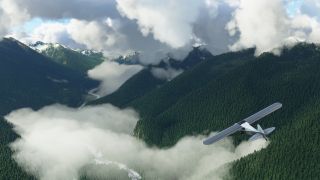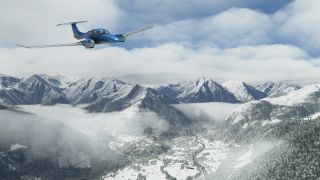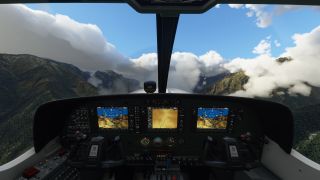I played the new Microsoft Flight Simulator for a week and I can't believe it's real
Go anywhere in the world, literally, in Microsoft's stunning new sim.

You can go anywhere in the world in Microsoft Flight Simulator. You rotate a 3D globe, find somewhere you want to fly, click on it, and after a loading break, you're there—either on the runway ready for takeoff, or in the air in mid-flight. Hong Kong, the Grand Canyon, Chernobyl, the French Alps, Hawaii, the tiny town you grew up in, the city where your office is. Anywhere you can think of, it's all there, and it all looks stunningly realistic. I don't know how they pulled this off, but it's an incredible technical and artistic achievement.
Well, I know a little about how they did it. Microsoft Flight Simulator uses satellite scans of the planet, courtesy of Bing Maps, which an algorithm then turns into a convincing 3D game world. I'm sure this is a gross oversimplification, but that's the basic idea. Get really close to the ground—closer than you ever would playing the game normally—and it's clear what you're looking at is satellite data. But from the air it is, in a very literal sense, photorealistic. That term is used too freely these days, but at certain times of day, when the weather and light are just so, it really is like watching footage of a real flight.
Check out some brand new gameplay footage in the video above
And it's all to scale as well. In real life it takes about 8 hours to fly from London to New York City in a Boeing 747—and it will in the game too. Luckily you can bring up a menu and skip parts of the flight, so if you want to jump straight to the descent into JFK without having to cross the entire Atlantic Ocean in real-time, you can. You can tweak other stuff mid-flight too, including the weather (down to individual cloud layers), the time of day, and even how much fuel your plane is carrying or the body weights of the pilot and passengers. The level of control you have over every aspect of the simulation is wild.
Some parts of the world have been crafted by hand, including airports and recognisable landmarks like the Pyramids, the Golden Gate Bridge, and the Tokyo Skytree. Bigger cities have been generated using photogrammetry data, meaning they look just like the real thing. Others, like the small city where I live in the north of England, aren't quite right. In many cases the algorithm tries to guess what a building looks like and gets it totally wrong. But again, you'll rarely be close enough to notice this during regular play. The important thing is that, from a height, the layout of any city you happen to be familiar with will be correct, and you'll feel like you're really flying over it.
In real life it takes about 8 hours to fly from London to New York City in a Boeing 747—and it will in the game too
The sense of scale is remarkable too. Soaring over the immense Australian Outback in a tiny single propeller plane, the sheer size—and emptiness—of the place really struck me. Flying across Norway's Lofoten Islands, the Himalayas, Iceland's Jökulsárlón glacier, the Mojave Desert, and other remote areas is awe-inspiring—and a reminder of just how vast and beautiful our planet really is. I feel a constant sense of wonder when I play Microsoft Flight Simulator, whether I'm flying past places I've visited in real life, or corners of the world I never knew existed.
In the preview build I played there were a few missions, including long distance endurance flights and landing challenges. And there will be more of these in the final game for anyone who likes a bit of structure. But honestly, I barely touched them. For me, the thrill of Microsoft Flight Simulator is picking somewhere at random, jumping in a plane, and flying. Having the entire planet at your fingertips is exhilarating, and I've lost hours to just cruising aimlessly over mountains, deserts, forests, volcanoes, and fjords, admiring the scenery and watching the dynamic weather change around me.
The biggest gaming news, reviews and hardware deals
Keep up to date with the most important stories and the best deals, as picked by the PC Gamer team.

Weather is another thing this game is extremely good at. When you fly into a storm, it's not just a big grey cloud with lightning shooting out of it—it's a gargantuan, evolving, voluminous, living thing. Snow, rain, clouds, and other meteorological phenomena are all realistically simulated and modelled, which means the weather behaves—and looks—exactly like it would in real life. And you can fine tune it, tweaking the temperature, precipitation, aerosol density, and a dozen other things to create the perfect storm. Or you can just set the skies to clear and enjoy the view stretching for miles ahead.
If you're new to the flight sim genre, the good news is that you can still play and enjoy Microsoft Flight Simulator—and you don't need a fancy flight stick either. The game is heaving with assists and accessibility options, meaning you can make it as hardcore or as laid back as you want. If you want a chill, gentle flying experience, exploring the world at your own pace without worrying about crashing or snapping your plane in half, you can. It even maps nicely to an Xbox controller, meaning you can connect your PC to the TV and play it sprawled on the sofa. I did this a few times and it worked really well.
It even maps nicely to an Xbox controller, meaning you can connect your PC to the TV and play it sprawled on the sofa
Of course, veteran players are well catered for too. Despite the increased focus on accessibility for newbies, this is still an incredibly deep simulator. It has native support for a bunch of peripherals, from yokes and throttles to sticks and pedals, and if you turn all the assists off, just keeping your plane in the air is hard work. All the buttons in the cockpit are functional and do whatever they do in a real plane. Wind affects aircraft realistically. Your windows and propellers can even ice over. When I saw the game at an event last year, the developers spent over an hour just talking about cloud simulation. If you're worried the game has been dumbed down, don't be.
There's a nice variety of planes too, and they all feel really different. The small planes operate better at low altitudes, making them ideal for soaring down valleys and skimming across cities. In some of the really small ones you can easily land somewhere picturesque, take in the view, then take off again. Then there are the airliners, including the mighty Boeing 747. Flying these massive, heavy, powerful things is kinda terrifying, and I'm amazed people do it for real every day. Hitting 30,000 feet for the first time is a special moment, and safely landing the things is so tense I often forget to breathe.

Of course, all this visual fidelity comes at a cost. Things may change between now and release, but Microsoft Flight Simulator is a real resource hog. On my PC (RTX 2080 Super, Intel i7-9700K, 16GB RAM) I could play it comfortably in 4K with the high-end preset, which is one below ultra. But it makes the fans in my PC spin like a jet engine, and I get some frame drops when I fly over somewhere dense and busy like, say, downtown Manhattan. You'll certainly need a decent PC to play this thing at high resolutions. But when you consider what it's doing under the hood, that perhaps isn't entirely surprising.
Calling things 'next-gen' has become increasingly meaningless, but Microsoft Flight Simulator probably deserves it. It's the first time in years a game's technology has truly, properly wowed me. It feels like the future. And it's exciting to think that this is just the first step in a ten year (at least) dev process. Microsoft and Asobo will be constantly updating the game, refining the algorithms, and making the world more realistic for months and years to come.
I just hope they don't hide all the best stuff behind expensive paid DLC and expansions, as so many sims have in the past. If you like the sound of Microsoft Flight Simulator, and want to see how accurately your house has been rendered, you only have to wait till August 18 to play it for yourself.
- Microsoft Flight Simulator autopilot: How to activate it
- Microsoft Flight Simulator locations: Where to visit first
- Microsoft Flight Simulator 2020 controls: The full list
If it’s set in space, Andy will probably write about it. He loves sci-fi, adventure games, taking screenshots, Twin Peaks, weird sims, Alien: Isolation, and anything with a good story.
Most Popular

